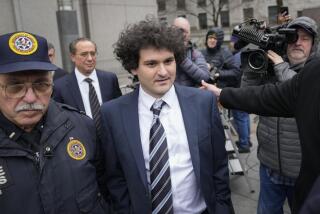This Web of Deceit Unearths Some Really Taxing Problems
- Share via
Shakespeare, that keen observer of human nature, had it right when he observed that it’s a tangled web we weave when we set out to deceive.
The web of his own design has ensnared Peter Graf through his complicated and, apparently, amateurish plan to hide millions of dollars of his daughter’s income.
Thanks to his tax-evasion trial, which began Sept. 5 in Germany, much that had been concealed is now revealed. The entire affair has become a morality play with all-too-human characters with all-too-familiar vices, chief among them, greed.
Just as Peter Graf’s ambition outstripped his abilities as a financial advisor, the trial’s revelations have gone beyond expectations and have ensnared not just Steffi Graf, but also have raised questions about what may be business as usual on the WTA Tour--the banned practice of appearance fees.
For more than a year, Graf’s financial dirty laundry has been hanging in public. Now her father, Peter, and tax advisor Joachim Eckhardt are on trial for charges that, between 1989 and 1993, they failed to declare $28 million in Steffi Graf’s income, thereby defrauding the German government of $13 million in taxes.
To hide the money, the prosecution claims, Graf and Eckhardt set up dummy companies to funnel cash to offshore tax havens. Eckhardt allegedly told prosecutors that not only was Peter Graf in over his head, trying to juggle all the cash transactions, but Steffi was aware of what was going. She has denied any knowledge of any impropriety regarding her taxes.
She has still not been fully cleared and the investigation continues. The web reaches others, too. Peter Graf has testified that German politicians agreed to let Steffi forgo paying taxes in return for her continued residence in the country. Many tennis player claim tax-free Monaco as their country of residence.
Tennis officials in Germany, too, seem to be accomplices, eager to display a national treasure such as Graf, and benefit from it. Articles in the German newsmagazine Der Spiegel last week said that Graf was paid more than $1.7 million in appearance fees by the German Tennis Federation over four years, just for playing in German tournaments. That figure does not include endorsements or prize money, it’s a guarantee just to show up.
The magazine also claims Peter Graf negotiated appearance fees from tournaments in Japan, Switzerland, Canada and the United States. Graf is said to have demanded cash payments for appearance fees and, in some instances, from sponsors.
At least some of the allegations have been substantiated during the trial. The general secretary of the German Tennis Federation admitted on the stand that Peter Graf was paid as much as $270,000 a year to ensure that his daughter played in tournaments in Germany.
That practice is banned on the WTA Tour, which specifies a fine of $50,000 and a suspension of up to three months for any player who, even indirectly, accepts money or anything of value as an inducement to play in a tournament.
The Der Spiegel article said the German prosecutor has documents that show Monica Seles and other top women players are regularly paid appearance fees, suggesting that Graf and Seles can demand up to $300,000 at some tournaments.
A statement released by the WTA said there is no evidence of appearance money being paid to any tour player. Yet the paying of appearance fees is an open secret in women’s tennis. The practice is allowed on the men’s tour and leads to some hilarious second-round “injuries” by top players who are happy to take the up-front money and run after a few days.
There is at least one other undisputed incident involving appearance payments to Graf. According to a lawsuit brought by promoter Ion Tiriac, in 1994 Peter Graf negotiated a $300,000 guarantee for Steffi to play in a tournament in Essen, Germany. Tiriac said he paid the money, but Graf pulled out of the event. Tiriac sued Peter Graf to recover the money.
It all ties together: That lawsuit is a key point in the Graf legal timeline. Tiriac’s suit was the whistle-blowing event that alerted German tax authorities to Graf’s potential undeclared income and got the whole thing started.
What makes the Tiriac scenario so interesting is the wily former player’s rumored role as takeover artist this season. He has, the story goes, been angling to usurp Advantage International and nab Graf’s lucrative management contract.
But according to Phil de Picciotto, Graf’s agent since 1987, he and Graf renegotiated their contract at the U.S. Open and Tiriac is out of the picture.
He said the new contract specifies that Peter Graf has no financial control over his daughter’s affairs and that Hans Engert, a former hitting partner, will manage Steffi Graf’s business dealings in Germany.
The trial is likely to go on for months. Expect a few more revelations before it’s over: It’s a tangled web and many are going to be caught in it.
Tennis Notes
For the first time, a challenger event will be played at the Hyatt Grand Champions at Indian Wells. The State Farm challenger, Oct. 13-20, will give four players a chance to earn spots in the main draw of other events on the WTA Tour. In the field are Kimberly Po of Rolling Hills, a former UCLA All-American who is ranked 41st, and Lindsay Lee, ranked 55th. Qualifying rounds are Oct. 13-14, the main draw on Oct. 15 and the final on Oct. 20. Admission is free.
More to Read
Go beyond the scoreboard
Get the latest on L.A.'s teams in the daily Sports Report newsletter.
You may occasionally receive promotional content from the Los Angeles Times.











